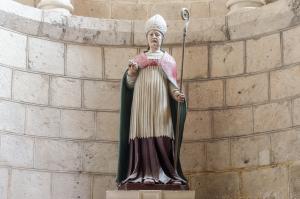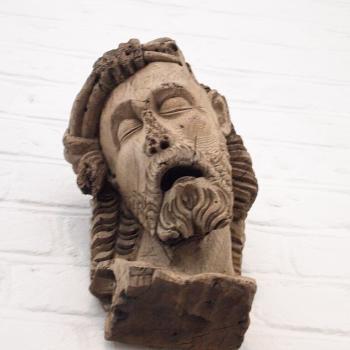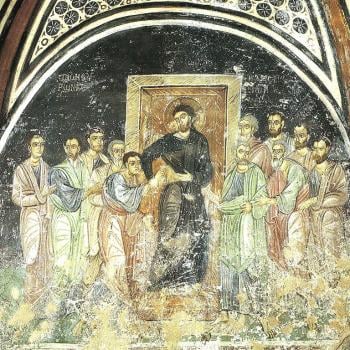
St. Hilary of Poitiers, a Doctor of the Church, was declared as the “Doctor of the Divinity of Christ” by Pope Pius IX in 1851. This is because he was one of the major defenders of the teaching of Nicea and the divinity of Christ during the 4th century. Indeed, he was one of the first Western (Latin-writing) bishops to focus his attention on the objections of the Arians and write a response to them. Even before he fully knew of and understood the teachings of Nicea (with its declaration that the Son was homoousios with the Father), he resisted the Arians and proclaimed the divinity of Christ. That was enough to get him sent into exile. It was during his exile that he came in contact with the Greek tradition, and with it, learned properly what was taught at Nicea, which he accepted as being what he had already taught (in and through other means).
Hilary knew the what was being debated was Christ’s divinity, and that any and all attempts to explain his eternal Sonship and the incarnation would suffer because of the limitations involved with human language and the logic which emerged from its language:
Thus our confession of God fails through the defects of language; the best combination of words we can devise cannot indicate the reality and the greatness of God. The perfect knowledge of God is so to know Him that we are sure we must not be ignorant of Him, yet cannot describe Him. We must believe, must apprehend, must worship; and such acts of devotion must stand in lieu of definition. [1]
While for those who study Christian history, and patristics, or even the names of the Doctors of the Church, the name of Hilary of Poitiers is easily a recognizable one, his works are far less studied, his theological opinion far less explored and expanded upon, than many other Doctors of the Church. This is in part because many of the questions he was asked, and so many of the questions which he answered, are far less troubling to Christians today than they were in his day. His focus on the Trinity concerned the divinity of Christ, and the relationship between the Father and the Son. Christians today are so accustomed to thinking of the Trinity and accepting it as a part of the Christian faith that they rarely question it, and if they do ask questions, they go to simpler, more modern sources to find easy answers. This means some of Hilary’s more unique ideas are ignored. This is not to say they need be accepted, but because he is a Doctor of the Church, and he is recognized as such due to his Christological work, they do provide an alternative orthodox view to Christ and how to understand his human existence, an alternative which could one day provide an interesting point of contact between Buddhist and Christians. For some of the questions he asked were similarly asked by Buddhists concerning Siddhartha, and some of the answers Buddhists give seem close to answers Hilary gave concerning the nature of the historical Christ. This can be found especially in the way Hilary addressed the question of pain and suffering in Christ. Hilary said that Christ truly encountered and faced such actions as a historical reality, but his consciousness did not experience it as we do, for though he can be said to suffer, he experienced none of the pain or grief associated with such suffering:
He had a body to suffer, and He suffered: but He had not a nature which could feel pain. For His body possessed a unique nature of its own; it was transformed into heavenly glory on the Mount, it put fevers to flight by its touch, it gave new eyesight by its spittle. [2]
This is, to be sure, rather peculiar, and it goes against the way we are normally led to think about Christ and his passion. Indeed, many have been concerned with the question as to whether or not Hilary’s teaching could be seen as some form of Docetism. Now, Docetism taught the body of Christ was not real, and all that he seemed to experience through it, he did not. Thus, to say he did not experience pain calls into question the reality of Christ’s body. We can read such a concern coming from Henri de Lubac; he believed that there was still a Docetic tendency in the writings of Hilary, a tendency which Lubac compared with the way Buddhists came to understand the historical Buddha:
Soon Christian Docetism was hardly able to survive except in the most diluted forms, barely to be distinguished from those of Christian orthodoxy – as can be seen in certain tendencies in the Christology of St. Hilary. In Buddhism the process was the exact opposite. The germs of Docetism which Buddhism carried within itself developed to a prodigious extent. The marvelous circumstances surrounding the baby Siddhartha’s arrival on earth are no more than the first stages of this process. However little the body of the future Buddha was supposed to have been truly “born”, this was soon found by the Mahayana to be unworthy of a perfect Buddha. At the moment of Bodhi a miraculous substitution must have therefore taken place. But even this was not sufficient.[3]
Henri de Lubac, nonetheless, suggested that the difference between orthodox Christology, even as it is found in the writings of Hilary, with Buddhism is that orthodox Christology took the world seriously, and the more orthodoxy took it seriously, the more it considered and examined the implications in relation to the historical person of Jesus Christ, while Buddhism, he believed, slowly depersonalized the historical Buddha, making whatever aspects of his life story more and more illusory as Buddhism developed. While one can, and should, question de Lubac’s understanding of Buddhism, he was right to say that orthodox Christianity slowly took more and more seriously the human side of Jesus, working out the implications of his experiences in relation to his consciousness. For many theologians, once the Arian crisis was behind them, it became much easier to acknowledge the possibility that Christ, in his humanity, experienced pain. But is it necessary for us to believe so? If we recognize Hilary as a Doctor of the Church, it would seem that his position, even if unusual, cannot be held as heretical and has the possibility of actually teaching us something about Christ, even if it goes against our general intuition.
It is clear, when we study his writings, the reason why Hilary was concerned with the question of whether or not Christ suffered pain was because the Arians suggested if he did, it proved he was not God. This is because God is impassible, and therefore, cannot experience pain. If Jesus is God, then as a person, it would seem he cannot feel pain, because God is impassible; on the other hand, if he feels pain, then the Arians suggested, he is passible and so not God. When Scripture seems to indicate he felt not only pain, but fear of pain, fear of death, the Arians said it showed that he was not God:
Thus the greater number of them will not allow Him to have the impossible nature of God because He feared His Passion and showed Himself weak by submitting to suffering. They assert that He Who feared and felt pain could not enjoy that confidence of power which is above fear, or that incorruption of spirit which is not conscious of suffering: but, being of a nature lower than God the Father, He trembled with fear at human suffering, and groaned before the violence of bodily pain.[4]
But, Hilary answered, though it seems as he suffers such pain, because in his passion, he is shown to suffer, he thinks a distinction must be made between the act of suffering and the pain associated with such suffering. Pain, he thinks, is the result of a consciousness contaminated by sin. But as Jesus’ consciousness was pure, and indeed, in a state of beatitude, though he physically experienced actions which would normally make people experience great agony, he did not feel such pain:
So the Man Jesus Christ, Only-begotten God, as flesh and as Word at the same time Son of Man and Son of God, without ceasing to be Himself, that is, God, took true humanity after the likeness of our humanity. But when, in this humanity, He was struck with blows, or smitten with wounds, or bound with ropes, or lifted on high, He felt the force of suffering, but without its pain. Thus a dart passing through water, or piercing a flame, or wounding the air, inflicts all that it is its nature to do: it passes through, it pierces, it wounds; but all this is without effect on the thing it strikes; since it is against the order of nature to make a hole in water, or pierce flame, or wound the air, though it is the nature of a dart to make holes, to pierce and to wound. So our Lord Jesus Christ suffered blows, hanging, crucifixion and death: but the suffering which attacked the body of the Lord, without ceasing to be suffering, had not the natural effect of suffering. It exercised its function of punishment with all its violence; but the body of Christ by its virtue suffered the violence of the punishment, without its consciousness. [5]
This is because pleasure and pain require more than mere physical actions, but combine with the way one’s consciousness merge with one’s circumstances and interprets them. What happens to the body is real, but how it is grasped and experienced by the person depends upon the way their soul (and consciousness) associates those experiences:
The nature of our bodies is such, that when endued with life and feeling by conjunction with a sentient soul, they become something more than inert, insensate matter. They feel when touched, suffer when pricked, shiver with cold, feel pleasure in warmth, waste with hunger, and grow fat with food. By a certain transfusion of the soul, which supports and penetrates them, they feel pleasure or pain according to the surrounding circumstances.[6]
Our souls, fallen as they are, lead us to experience pleasure and pain through our bodies; Jesus, however, has a soul which reflects his perfect divinity, and so is blessed and beyond the pleasure and pain we normally experience. He opened himself up to the passion, to having a body which can experience the things of history and the world, and so suffer, but to suffer, to let things happen to his body, is not the same thing as feeling pain. He remained God in his person, and so his soul remained in beatitude and glory:
By the virtue of the Spirit and the power of God the Word, though He abode in the form of a servant, He was ever present as Lord of all, within and beyond the circle of heaven and earth. So He descended from heaven and is the Son of Man, yet is in heaven: for the Word made flesh did not cease to be the Word. As the Word, He is in heaven, as flesh He is the Son of Man. As Word made flesh, He is at once from heaven, and Son of Man, and in heaven, for the power of the Word, abiding eternally without body, was present still in the heaven He had left: to Him and to none other the flesh owed its origin. So the Word made flesh, though He was flesh, yet never ceased to be the Word. [7]
Hilary believed that this was not only true for Christ. He believed it was possible for any one of us. Thus, he said, the records of many martyrs indicate how they were able to have bad things happen to them and yet show no indication of feeling any of the anxiety, pain, or sorrow associated with what happened to them. [8] For Hilary, pain, then, requires more than something bad happening to us through our body, but needs the soul with its consciousness to use that suffering as a way to activate that pain for us. An impure consciousness, an impure soul, still tainted by sin, can and will experience such pain, because sin hinders our experience of beatitude. What is seen as a miracle, such as seen in the story of the three youths put in the oven in the book of Daniel, might better represent natural humanity, that is, the unfallen state of humanity and the consciousness which we can attain in and through grace. If it is possible to find many examples of people who should have experienced pain but did not, and it is, we can begin to understand the passion of Christ. Christ is pure. Many of the martyrs were spiritually pure (or became purified in the process of martyrdom), and so they can be said to suffer, but none of them experienced the negative consequences of such suffering which comes as a result of sin and concupiscence. The martyrs, then, follow Christ, showing it is not necessary for humanity to experience pain, but rather, it is the consequences of a consciousness which inordinately grasps after the body and its sufferings over and above its potential spiritual happiness. Suffering is real; pain is but a way to engage and experience the suffering, but it is not necessary. Nothing will take them away from the joy of those who are full of grace and experience the beatitude of the kingdom of God within themselves.
While it might appear that Hilary offered a Docetical approach to the passion, what he did was question how we understand pain, not how we understand the reality of the body. “For his own part, Hilary directly rejects Docetism, insisting that Christ had a truly fleshy body which shed its blood.”[9] It is all a matter of the state of his consciousness. While this might not seem to be a typical Christian belief, it affirms the reality of Jesus’ historical experience, making it stand against Docetism, while allowing for a differing interpretation of what it meant for Jesus. Thus, E. Jerome Van Kuiken explained:
Hilary seeks to defend Christ’s identity as one person who is simultaneously truly God and truly human, but the bishop depicts the divine attributes of omniscience and impassibility as nearly reducing Christ’s human limitations to epiphenomena: his hunger, thirst, and tears, his confession of ignorance and cries from Gethsemane and Golgotha – all are adaptations to human custom, not expressions of genuine weakness. [10]
Peter Lombard understood the difficulty that Hilary’s text provided, but he ended up affirming what Hilary said:
If you note with diligence what is said above and explore the context of what was written, you will then be able to understand as best you can the reason and power of what was said and will not try to fault its meaning. For it is clear that he said that there was no pain and suffering in Christ, and that the power of Christ’s body received the force of pain without feeling it because Christ did not have in himself the cause of pain or deserve to feel it. This seems to have been pointed out when he says: ‘he did not have a nature able to feel pain.’ And so his flesh is not to be judged according to the nature of our body. Nor did suffering have dominion over him. Hence he also did not have a nature to fear or to be sad, because he did not have such a nature as might contain a cause of fear or sorrow. Therefore in him there was no necessity to fear, as there is in us; nor was there in him a nature of suffering, as there is in us.[11]
Hilary suggested that Christ did not have within him that element of the consciousness which causes us to feel pain. What is the cause of pain? Certainly, an element of it is the fact that those who are in pain, suffers. But for Hilary, it is more than mere suffering. It requires a consciousness which is not yet full of grace, and so a consciousness which, tainted by sin, interprets and engages that suffering so that it reads such suffering as pain. For him pain is a part of the consequences of sin. Even if someone has been forgiven their sin, they still have to deal with the consequences of their sin, consequences which include the way they interpret their experiences. Pain, it can be said, is a state of being which comes through sin, but as Christ has no sin, there is no state of being within him which allows him to experience suffering in the way those who experience it due to sin. Christ is perfectly human, purely human, in his humanity, and so humanity should be viewed in relation to him and what he shows concerning it, instead of having Christ interpreted by the way we understand humanity. Thus:
The question about Christ’s human experience then is not a question of whether or not he had a human body or nature, but what type of fully human body and soul Christ had, as he explicitly rejects the docetic option of a phantom (fantasma) body. [12]
Jesus’ body is real. What was seen to happen to it, truly happened. That is Hilary’s position, and as such, he was not a Docetist. His view might seem strange. It might seem counter-intuitive, but on the other hand, it seems to imply truths, not just about Christ, but about us. Pain is not natural to humanity. It is for this reason saints will transcend all experience of pain, but on the other hand, it gives a way to explain the pains associated with purgatory and hell. For pain is an issue of our state of being. When we come face to face with God, how we experience it will be based upon the state of our consciousness. While it is a great and marvelous thing, for many, instead of bringing them much joy, it will cause them great grief, not because God is anything but good, but because their own consciousness has yet to be prepared to experience his glory. The general resurrection of the dead is a good thing for all; the way people experience it will depend on the state of their consciousness; thus, the resurrection, which is good, and indeed, blessed, can cause pain to those not purified from all the effects of sin, even as what can be said to be less than good, the suffering which is inflicted on bodies, is capable of being experienced without pain by those whose consciousness is pure. Hilary, though unusual, offers us a way to understand a truth about heaven and hell, seeing that they are one and the same, the kingdom of God, with the difference being not where we are, but the state we find ourselves when there. Once we understand this, then we can understand Hilary and why his position, far from being Docetical, affirms the reality of what Christ suffered without expecting Christ to experience the pain we normally associate with such suffering. It also suggests to us we should consider the relationship with sin and pain, and how sin affects our consciousness so that we experience pain and grief. This, then, opens up Christianity to a dialogue with various schools of Buddhist thought, such as Yogācāra, because they, too, are concerned with the relationship between consciousness and the way people experience reality.
[1] St. Hilary of Poitiers, “On the Trinity” in NPNF2(9):54.
[2] St. Hilary of Poitiers, “On the Trinity,”188.
[3] Henri de Lubac, Aspects of Buddhism. Trans George Lamb (London: Sheed and Ward, 1953), 119.
[4] St. Hilary of Poitiers, “On the Trinity,” 184.
[5] St. Hilary of Poitiers, “On the Trinity,” 187-8.
[6] St. Hilary of Poitiers, “On the Trinity,” 185.
[7] St. Hilary of Poitiers, “On the Trinity,” 186.
[8] See Jarred Mercer, “Suffering for Our Sake: Christ and Human Destiny in Hilary of Poitiers’s De Trinitate” in Journal of Early Christian Studies vol. 22 no. 4 (2014): 557.
[9] E. Jerome Van Kuiken, Christ’s Humanity in Current and Ancient Controversy: Fallen or Not? (London: T&T Clark, 2017), 135.
[10] E. Jerome Van Kuiken, Christ’s Humanity in Current and Ancient Controversy: Fallen or Not?, 135.
[11] Peter Lombard, The Sentences: Book 3. On the Incarnation of the Word. Trans. Giulio Silano (Toronto: Pontifical Institute of Medieval Studies, 2008), 64-5 [ Dist. XV. C. 3).
[12] Jarred Mercer, “Suffering for Our Sake: Christ and Human Destiny in Hilary of Poitiers’s De Trinitate,” 555.













